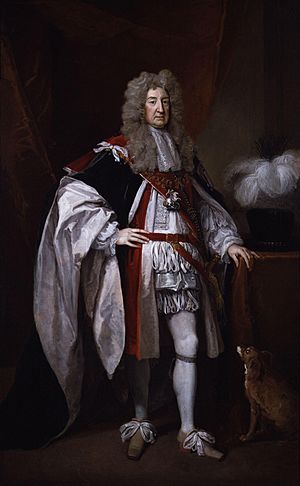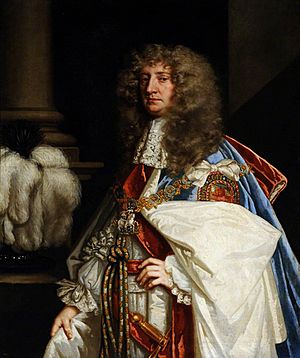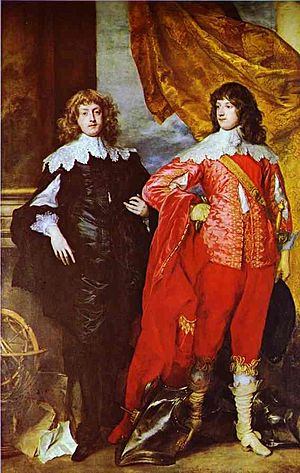William Russell, 1st Duke of Bedford facts for kids
Quick facts for kids
The Duke of Bedford
|
|
|---|---|

Portrait by Godfrey Kneller
|
|
| Tenure | 11 May 1694 – 7 September 1700 |
| Successor | Wriothesley Russell, 2nd Duke of Bedford |
| Other titles | 1st Marquess of Tavistock 5th Earl of Bedford 5th Baron Russell 3rd Baron Russell of Thornhaugh 1st Baron Howland |
| Born | August 1616 |
| Died | 7 September 1700 (aged 84) |
| Spouse(s) | Anne Carr, Countess of Bedford |
| Issue | Francis Russell William Russell John Russell Edward Russell Robert Russell Anne Russell James Russell George Russell Diana Russell Catharine Russell Margaret Russell |
| Parents | Francis Russell, 4th Earl of Bedford Catharine Brydges |
William Russell, 1st Duke of Bedford (born August 1616 – died 7 September 1700) was an important English nobleman and politician. He was a member of the House of Commons (a part of Parliament) from 1640 to 1641. After his father died, he became the 5th Earl of Bedford and moved to the House of Lords. He played a role in the English Civil War, first fighting for Parliament, then for the King, and later trying to return to Parliament's side. He was later made a Duke, which is a very high rank.
Contents
William Russell's Early Life (1616–1640)
William Russell was born in August 1616. His father was Francis Russell, 4th Earl of Bedford. His mother was Catherine Brydges.
He studied at Magdalen College, Oxford. In 1635, he traveled to Madrid, Spain, hoping to learn Spanish. He came back by July 1637. Around this time, he married Anne Carr. Her father was Robert Carr, 1st Earl of Somerset. His own father was not happy about the marriage at first.
His Role in the English Civil War (1640–1644)
The English Civil War was a big conflict in England. It was fought between those who supported Parliament (called Roundheads) and those who supported King Charles I (called Royalists).
Bedford as a Parliament Supporter (1640–1642)
In April 1640, William Russell was chosen as a Member of Parliament (MP) for Tavistock. He was chosen again in November 1640 and served until 1641. Like his father, Russell chose to support Parliament in its arguments with King Charles I. These arguments soon led to the Civil War.
In May 1641, Russell's father died suddenly. William then became the 5th Earl of Bedford. Even though he was only 24, Parliament gave him important jobs. He was made a commissioner to talk with the King in 1641. He also became Lord Lieutenant of Devon and Lord Lieutenant of Somerset in 1642.
On July 14, 1642, he was made General of the Horse (a cavalry leader) for Parliament. In September, he led an army in western England against the King's forces. Even though Bedford had more soldiers, his troops were not well trained. Many of them left. When he returned to London, people criticized his actions.
The next month, he joined Robert Devereux, 3rd Earl of Essex. He fought with the Parliamentarians in the Battle of Edgehill on October 23, 1642.
Bedford as a Royalist (1643)
By the summer of 1643, Bedford wanted to make peace with King Charles I. He joined a group in Parliament that wanted a settlement. When the main Parliament leader, Essex, refused this idea, Bedford decided to leave Parliament's side. He joined King Charles I at Oxford. The King forgave Bedford for fighting against him before.
Bedford then fought for the Royalists. He was part of the Siege of Gloucester (August 3 – September 5, 1643). He also fought in the first Battle of Newbury (September 20, 1643).
Bedford Tries to Return to Parliament (1643–1644)
Even though King Charles I had forgiven Bedford, the King's closest advisors did not fully trust him. They only gave him small responsibilities. Feeling disappointed, Bedford went back to the Parliament side in December 1643. He said he had only been trying to make peace with the King and never meant to leave Parliament.
However, Parliament was also careful about a person who had changed sides. They did not let Bedford take his seat back in the House of Lords.
Stepping Away from Public Life (1644–1660)
The army's actions became more extreme in the mid-1640s. This made Bedford uncomfortable. He decided to leave public life and went to his home at Woburn. He did not play a big public role during the time when England had no king, known as the English Interregnum.
His Career After the King Returned (1660–1683)

When the King returned to power in 1660 (called the Restoration), Bedford got his seat back in the House of Lords. He became a leader of the Presbyterian group, which was a type of Protestant church.
Bedford carried the sceptre at King Charles II's coronation in 1661. But he was never very close to the King.
King Charles II tried to get Bedford's support. In 1671, he made Bedford Governor of Plymouth. On May 29, 1672, he made him a Knight of the Garter. This is a very special honor. He also held the job of Joint Commissioner for the office of Earl Marshal in 1673. However, the King's efforts to win Bedford over did not last.
Bedford went to services at the official Established Church. But he also had a Presbyterian chaplain (a religious leader) in his home. His wife was even arrested in 1675 for going to a private religious meeting. Because of this, Bedford naturally joined those who opposed the King's plans to make the Church of England more powerful. Bedford supported the Whigs during the Exclusion Crisis. This was a time when people argued about who should be the next king.
As a result, the King turned against Bedford. In 1682, the town of Tavistock, which was important to Bedford's family, lost its special rights.
Stepping Away Again (1683–1688)
In 1683, Bedford's son, William Russell, Lord Russell, was involved in something called the Rye House Plot. He was later executed. After this sad event, Bedford stopped being involved in politics.
His Career Under William and Mary (1688–1700)
Bedford returned to public life during the Glorious Revolution. This was when William and Mary became King and Queen. He again carried the sceptre at their coronation. He was also made a member of the Privy Council. This is a group of important advisors to the King or Queen.
In 1689, he became Recorder (a type of judge) of Cambridge. He was also Lord Lieutenant of Cambridgeshire and Lord Lieutenant of Bedfordshire from 1689 to 1700. He was Lord Lieutenant of Middlesex from 1692 to 1700.
On February 14, 1689, he became a Privy Counsellor. On May 11, 1694, he was given the very important titles of Duke of Bedford and Marquess of Tavistock. He was also made Baron Howland of Streatham on June 13, 1695. This title was meant to pass to his grandson, Wriothesley Russell.
William Russell died on September 7, 1700, at the age of 84. He passed away at Bedford House in London. He was buried on September 17 at St. Michael's Church in Chenies, Buckinghamshire.
Marriage and Family
William Russell married Anne Carr on July 11, 1637. She was the daughter of the Earl of Somerset. They had several children:
- Francis Russell, Lord Russell (1638–1678), who never married.
- William Russell, Lord Russell (1639–1683), who married Lady Rachel Wriothesley and had children.
- John Russell, who died when he was a baby.
- Lord Edward Russell (1643–1714), who married Frances Williams in 1668.
- Lord Robert Russell (around 1645–around 1703), who married his cousin Letitia Cheek in 1690.
- Anne Russell (around 1650–1657), who sadly died after eating poisonous berries at Woburn.
- Lord James Russell (around 1651–1712), who married Elizabeth Lloyd and had children.
- George Russell (around 1652–1692), who married Sarah Milby.
- Lady Diana Russell (1652–1701), who married Greville Verney, 9th Baron Willoughby de Broke and later William Alington, 3rd Baron Alington of Killard. She had children from both marriages.
- Catharine Russell, who died young.
- Lady Margaret Russell (1656–around 1702), who married her first cousin, Edward Russell, 1st Earl of Orford.


